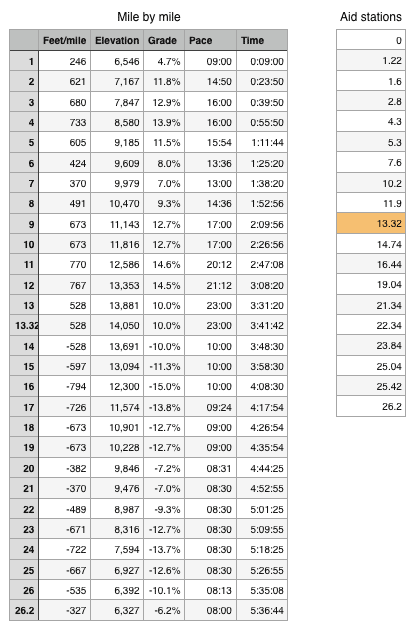I consider this to be a "for fun" race in that I don't really have any aspirations to PR or win an age group award. But of course it is a serious challenge, and I'd like to do as well as I can.
So for me, naturally, that means spreadsheets. The Pikes Peak Marathon climbs 7,800 feet on a trail from Manitou Springs Colorado at an elevation of 6,300 feet to the top of Pikes Peak at an elevation of 14,050 feet — and then back down. This is higher than I've ever stood on the ground, let alone higher than I've ever run! Over the past two weeks, however, I have climbed to elevations as high as 12,500 feet, and I've run to over 13,000 feet before, so I think I should be able to handle the elevation.
That doesn't mean the elevation won't slow me down a bit — or, rather, a lot! But how much, exactly? The Pikes Peak Marathon home page offers the following rule of thumb for "flatlanders" doing the race for the first time:
On the ascent, take your flatland marathon PR and add 30 minutes. So over 13.32 miles you actually will likely be slower than your best effort for a full 26.2! My PR is 3:22, which puts my estimated ascent time at 3:52. I'm being slightly more optimistic than that because I've been spending these last two weeks acclimatizing to the elevation and will have had nearly three weeks at elevation by race morning. On the descent, even though it's downhill, the organizers suggest multiplying your marathon PR by 0.6. That means you'll be running 20 percent slower than your marathon pace, on a downhill burner of a course. I believe that -- I could only manage about 7:40 per mile on the descent at The Scream a few weeks ago, and that wasn't at nearly the elevation of this course. With that in mind, I've created this spreadsheet as a guide for what pace to shoot for. I plan on laminating it and carrying it with me during the race:
 |
| Note that aid stations are not at even mile-points |
This has me at the summit in 3:41, a 16:35 pace, and gives me about 1:55 for the descent, just under a 9-minute average pace.
My wife Greta will be meeting me at the top; she's taking a train up there and will be arriving about 3:35 after the start, or just 6 minutes before my race plan has me arriving. I have been instructed that I am not allowed to leave the summit without seeing her, which gives me a tremendous incentive not to exceed my planned pace. I'd just be sitting around waiting for her at the top!
So what will happen when I get there? There's another spreadsheet for that:
 |
| Yes, I really do have a spreadsheet entry to remind me to clip my toenails! |
Hopefully all I will need to do is put on the short-sleeved shirt, add some sunscreen and Trail Toes lube (I prefer this to the more-commonly-used Body Glide) and head back down the mountain.
I had initially planned on changing shoes at the top as well, starting off with light trail shoes and switching to Hokas. But I had such good luck at The Scream and the Kennebec Mountain Challenge just wearing the Hokas that I've decided not to add that variable to the mix and just stick with the same pair of shoes the whole way.
...and I think that's about it. I might modify things somewhat if the weather outlook changes significantly. Right now the forecast calls for a low of 36 and high of around 65 above 11,000 feet on race day, but of course that could change significantly in 5 days! It has been known to snow on runners during this race. So I'll try to be prepared for everything but expect that the weather should continue in the same moderate pattern I've seen over the past week or so in Colorado.
Wish me luck!

No comments:
Post a Comment